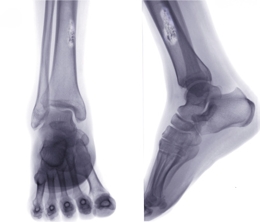Every year, about 1,00,000 Americans with cancer discover that their cancer has spread to the bones. The condition is known as metastatic bone cancer. Get in-depth information about this cancer in the following article.

Secondary bone cancer or bone metastases refers to cancer that actually starts in a totally different location, organ, or area of the body, and then spreads to the bones. It has been found that 90% of these cancers are caused by primary breast cancer, lung cancer, kidney cancer, prostate cancer, and thyroid cancer. In the following paragraphs, we shall discuss its causes, symptoms, treatment, and prognosis.
Causes
➜ Bones are made up of calcium, phosphate, and protein collagen. On the outside, they are made up of cortex and the spongy center of the bone is called cancellous bone. The spaces between the spongy center is made up of the bone marrow.
➜ The bone marrow is where the red blood cells (help in the transportation of oxygen), white blood cells (help in fighting infections), and platelets (help in blood clotting) are produced.
➜ Cancer cells from a primary tumor, i.e., cancer of another organ, break off and travel to other parts of the body through the lymphatic system or blood stream. These cancerous cells get lodged in some other part that may be far away from the original area.
➜ There are certain areas where certain cancer types tend to spread, like the bones or liver. Primary cancers that spread to the bones are called bone metastasis. These secondary bone cancers are not the same as bone sarcoma, i.e., those originating within the bone.
➜ The bone metastasis consists of cancerous cells that are similar to those present at the original tumor site and are not abnormal bone cells. The cancer cells generally prefer to lodge themselves in the middle of the body.
➜ Therefore, the most common site for the spread of cancer is the spine. Other bones affected by secondary cancer are pelvis, upper leg bones, upper arm bones, ribs, and skull.
➜ Secondary bone cancer tends to wear away tiny bone pieces that leads to osteolytic lesions. This makes them fragile and prone to bone fractures. The cancer may also stimulate the bones to form and build up abnormally.
➜ These new bones formed are known as osteoblastic or osteosclerotic lesions. They are very weak and tend to break or collapse very easily. The person tends to experience immense pain at this site.
Symptoms
There are many symptoms that arise due to bone metastasis. A few have been mentioned below:
► Bone Pain
One may suffer from fluctuating pain in the bone that may appear and then disappear. Most of the time, the pain is severe at night and as the cancer spreads, the bone pain gets worse.
► Fractures
Bones that get easily fractured or a sudden pain in the spine are indicative of a broken bone of the spine due to secondary cancer.
► Spinal Cord Compression
The spine may get compressed, which may cause pain, numbness, weakness in the legs, problems with bladder and bowels, etc.
► High Calcium Levels in the Blood
Hypercalcemia leads to low appetite, nausea, thirst, constipation, confusion, and fatigue. When left untreated, it may result in the person going into a coma.
► Low Blood Cell Count
Bone metastasis may result in a low red blood cell count leading to anemia, weakness, shortness of breath, etc. It may also result in a low white blood cell count leading to frequent infections, fever, chills, fatigue, etc. A low platelet count may lead to abnormal bleeding.
Treatment
There are many treatment options that help in managing this secondary cancer. The treatment options include:
- Use of bisphosphonates
- Chemotherapy
- Hormone therapy
- Radiation therapy
- Surgery
- Pain management therapy like physical therapy and making use of non-steroidal anti-inflammatory drugs
Prognosis
The prognosis for bone metastases is poor. It causes considerable pain and loss of mobility in the patient. The treatment generally aims at making life better for the cancer patient. The average survival rate after diagnosis is about 24 to 36 months with treatment and therapy. The life expectancy depends on different factors, which include the progression of the disease, type of primary cancer, and aggressiveness of the cancerous cells. There are different stages of bone cancer, and the prognosis as well as survival rate both depend on the stage of the disease.
You need to consult the doctor regarding the disease as well as its progression. There are many clinical trials available that may assist in the treatment, but you need to speak to your doctor about every little detail regarding the trial before volunteering. Take care!
Disclaimer: This Buzzle article is for informative purposes only and should not be used as a replacement for expert medical advice.


 Secondary bone cancer or bone metastases refers to cancer that actually starts in a totally different location, organ, or area of the body, and then spreads to the bones. It has been found that 90% of these cancers are caused by primary breast cancer, lung cancer, kidney cancer, prostate cancer, and thyroid cancer. In the following paragraphs, we shall discuss its causes, symptoms, treatment, and prognosis.
Secondary bone cancer or bone metastases refers to cancer that actually starts in a totally different location, organ, or area of the body, and then spreads to the bones. It has been found that 90% of these cancers are caused by primary breast cancer, lung cancer, kidney cancer, prostate cancer, and thyroid cancer. In the following paragraphs, we shall discuss its causes, symptoms, treatment, and prognosis.